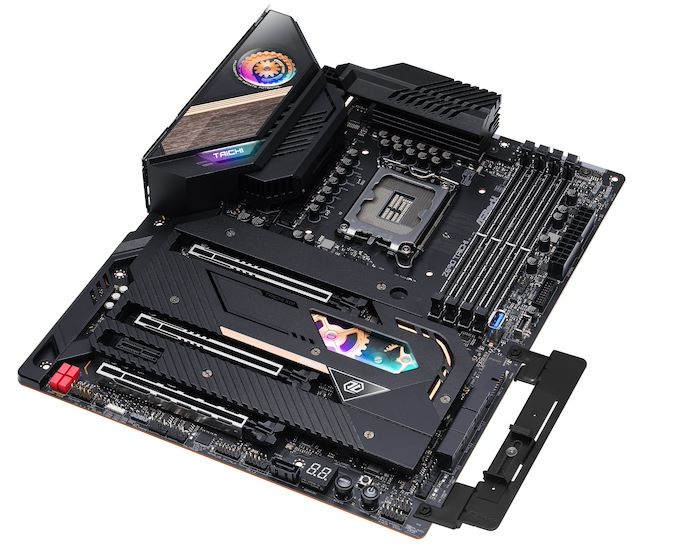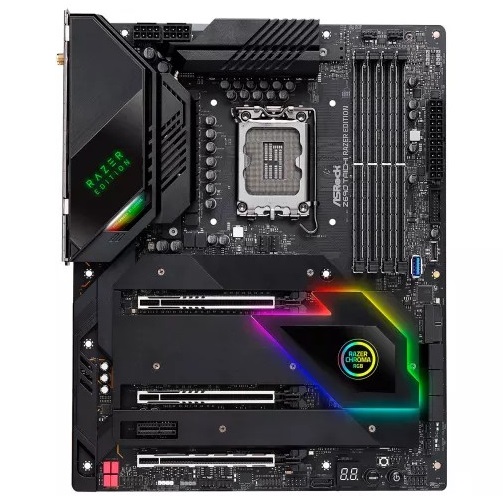The Intel Z690 Motherboard Overview (DDR5): Over 50+ New Models
by Gavin Bonshor on November 9, 2021 9:00 AM ESTASRock Z690 Taichi & Z690 Taichi Razer Edition
Kicking off our Z690 overview in alphabetical order, we'll start with ASRock. ASRock includes its patent-pending ASRock Graphics Card Holder with all of its Z690 models. This is designed to help prevent sagging when used with heavier and long graphics cards.
As it currently stands, the most premium model in ASRock's arsenal for Z690 is from one of its most successful motherboards series, the Taichi. The ASRock Z690 Taichi has a variety of premium features including an advertised 20-phase power delivery with the latest 105 A power stages, as well as a slightly redefined look for 2021. Touching on the design, ASRock includes its mechanical cogwheel effect built into the rear panel cover, which includes RGB LED backlighting, with more RGB built into the cleverly designed cogwheel inspired chipset heatsink.
Looking at the lower portion of the Z690 Taichi, it includes three full-length PCIe slots, including the top two operating at PCIe 5.0 x16 and x8/x8, a third full-length PCIe 4.0 x4 slot, and one PCIe 3.0 x1 slot. Focusing on storage, the ASRock Z690 Taichi includes two PCIe 4.0 x4 M.2 slots, with a third M.2 slot that has support for both PCIe 3.0 x4 and SATA drives. The board also features seven SATA ports in total, with six of these supporting Intel RAID 0, 1, 5, and 10 arrays. Located in the top right-hand corner are four memory slots that can support DDR5-6400, with a combined capacity of up to 128 GB.
The ASRock Z690 Taichi Razer Edition shares the same feature set as the regular Z690 Taichi, but with a Razer-inspired twist. This includes a funky Razer Edition logo on the rear panel cover, with Razer Chroma RGB LED lighting which from the image above, pops really nicely. It drops the cogwheel theme of the Taichi and essentially replaces it with Razer branding.
On the rear panel of the ASRock Z690 Taichi is a pair of Thunderbolt 4 Type-C ports, with two USB 3.2 G2 Type-A, and four USB 3.2 G1 Type-A ports. Onboard audio is handled by a Realtek ALC1220 HD audio codec and ESS Sabre 9218 DAC pairing and consists of five 3.5 mm audio jacks and one S/PDIF optical output. Interestingly, ASRock has put the audio connectors in the middle of the rear panel, as opposed to the end. For networking, ASRock is using a Killer E3100G 2.5 GbE controller, with an additional Intel I219-V Gigabit controller, with a Killer AX1675 Wi-Fi 6E CNVi. Finishing off the rear panel is a single HDMI 2.1 video output and a small BIOS Flashback button.













126 Comments
View All Comments
Kevin G - Wednesday, November 10, 2021 - link
The current LGA 1700 platform from Intel is set for three generations: Alder Lake, Raptor Lake, and Meteor Lake. In that time frame with future generations as well as AMD releasing AM5, featuring DDR5 and PCIe 5.0 support as well, will remove the current premium prices and reach parity with what we have today. Even in the short term, Intel supports DDR4 on Alder Lake and the various Alder Lake i3's and lower will arrive in less than 6 months further reducing prices.The big feature of PCIe 5.0 isn't the additional bandwidth but on the server side it'll bring CXL. For consumers, I wouldn't be surprised if AMD enables their PCIe 5.0 slot to switch over to an Infinity Fabric mode when paired with a Radeon graphics card. (AMD recently announced something similar with Epyc and CDNA2.) The benefits wouldn't be the bandwidth but rather lower latencies between devices and increased efficiencies due to coherency/direct memory access. The way things are aligning, this could arrive in late 2022.
X58 did have a few cards that took advantage of PCIe 2.0 right away (dual 10 Gbit networking on an eight lane PCIe 2.0 cards). Beyond that, multi-GPU was emphasized by both nVidia and AMD at the time giving some usage to those additional lanes. X58 wasn't the first DDR3 platform from Intel but it still carried a premium over DDR2 when it was first introduced.
Intel HEDT is currently dead with the glimmer of hope that Saphhire Rapids brings it back. However, I'd expect any Sapphire Rapids HEDT platform to be half of what Intel is offering on the server side (dual chiplet instead of quad chiplet). AMD still has Zen 3/Zen 3D Threadrippers to launch to counter.
Bp_968 - Wednesday, November 10, 2021 - link
Ahh, X58. Good stuff. I upgraded from an X58 system in 2017 and its still going strong as my neighbors PC. It took 6+ cores and (more importantly) NVMe storage to dislodge its position as "good enough" while i spent the PC money on video cards and I finally got a 8700k in 2017.I expect something similar to happen for my next upgrade. A new memory tech, pcie5, and more and faster USB at the minimum, and at a lower price than these 690 boards. I don't expect that until zen 4 at the earliest so late 2022 early 2023. But even then i doubt CPU performance will be the killer feature that forces me to upgrade. It will be something related to IO or memory. Bleeding edge CPU performance just isnt that relevant to most gamers anymore. And the upgrade cycles have slown down so much compared to the past. I remember when year or two old hardware was at risk of being unable to play the latest titles!
JasonMZW20 - Monday, November 15, 2021 - link
I don't see much advantage for PCIe 5.0 dGPUs, but PCIe 5.0 SSDs should offer improved sequential read/write speeds with more NAND layers. Unfortunately, in Z690, you'd need to use a PCIe 5.0 -> NVMe expansion card, as mobo NVMe are 4.0 only. I wonder how that will be handled. Some early Z690 slides listed support in 5.0 expansion slots for Intel SSDs only.Oof, these motherboard prices are pretty high. I struggle to justify anything over $400, especially in mainstream market.
mode_13h - Monday, November 15, 2021 - link
> PCIe 5.0 SSDs should offer improved sequential read/write speeds with more NAND layers.Why? What's the use case for > 8 GB/sec storage reads/writes, in a consumer desktop? And I'm not aware of a consumer SSD that's even maxed out PCIe 4.0 x4, BTW.
These are probably the reasons Intel didn't bother with it. However long it takes consumer GPUs to support PCIe 5.0, SSDs could take even longer. And with Raptor Lake coming in just <= 1 year, Intel will soon have another chance to re-evaluate whether a PCIe 5.0 M.2 slot makes any kind of sense.
Samus - Tuesday, November 9, 2021 - link
Yeah, definitely too much for a "current" system - you can't use half the tech you are paying for because there is literally nothing on the market, and there likely won't be for a year. I mean we are only at Gen2 PCIe 4.0 SSD's, and only recently did PCIe 4.0 GPU's launch (if you could call it that since they are still difficult to even buy.) On top of that, the difference in most applications (like GPU's, for example) between PCIe 3.0 and PCIe 4.0 is almost nothing, because the bus isn't the bottleneck.Other than TB4, I don't know what PCIe 5.0 is going to be good for in the near term because PCIe 4.0 is already a lot of bandwidth even in small lanes. Obviously PCIe 5.0 has more bandwidth in narrower lanes, but again, in desktop\mobile platforms there isn't a lot of demand for that much bus bandwidth.
Definitely a technology showcase launch more than a marketable one.
Kakkoii - Thursday, November 11, 2021 - link
I will say in regards to PCIe 5, there is the advantage that you can do more on the board with less lanes. Some of these boards split the PCIe 5 lanes between two x16 slots, effectively giving you two full speed PCIe 4.0 x16 slots, instead of x8/x8.While this still won't benefit you much in most games, it's a big help for anyone who uses multiple GPUs for workstation purposes, or needs extremely high-speed storage in the second slot.
DanNeely - Tuesday, November 9, 2021 - link
Did Intel say why they upped the number of SATA ports to 8? If the number were to change at this point, I'd expect it to start going down.With M.2 SSDs having largely displaced SATA models the demand for SATA continues to dwindle outside of DIY NAS systems for which a much cheaper basic chipset mobo is suitable. With only about 1 in 10 mobos adding the last 2 ports the mobo makers mostly seem to agree that it was unneeded as well.
Silver5urfer - Tuesday, November 9, 2021 - link
Its for RAID, they are adding some RAID features. And M.2 is nothing vs SATA. M.2 all drives are basically TLC, only MLC ones are 970 Pro which are now obsolete. SATA gets you 860 PRO MLC 4TB drives. Plus M.2 is barely useful in gaming, at max reduces load times by a fraction vs regular SATA SSD plus they get wayy too hot for what they have in mediocre endurance, capacity and usefulness in general purpose workloads.Bonus is SATA gets you NAS class devices - WD Red / Seagate Exos etc, no need to buy extra NAS and deal with Plex and all simply run all your media on your own PC. I bet many like that option when they do not prefer any TV or others.
Really unfortunate that everyone dropping them even ASUS Apex dropped it this time, only EVGA is offering on their mobos, and ASRock.
lilkwarrior - Tuesday, November 9, 2021 - link
It seems to be a tangent on your part, but games currently don't even leverage PCIe 3 SSD speeds. When DirectStorage is utilized by actual games, your statement becomes grossly false when it comes to NVMe M.2 SSDs vs SATA SSDs.If you need endurance and so on, most pros would opt for Intel Optane in U.2. format (that you can alternately slot in through a PCie or M.2 adapter.
Silver5urfer - Tuesday, November 9, 2021 - link
Yeah I have been hearing the same BS ever since DX12 came out and where are we with those promises ? Talk when tech is there do not place ladders in sky. PCIe4.0 itself is useless even in benchmarks for GPUs a minor boost at very very high FPS is all it is at now.